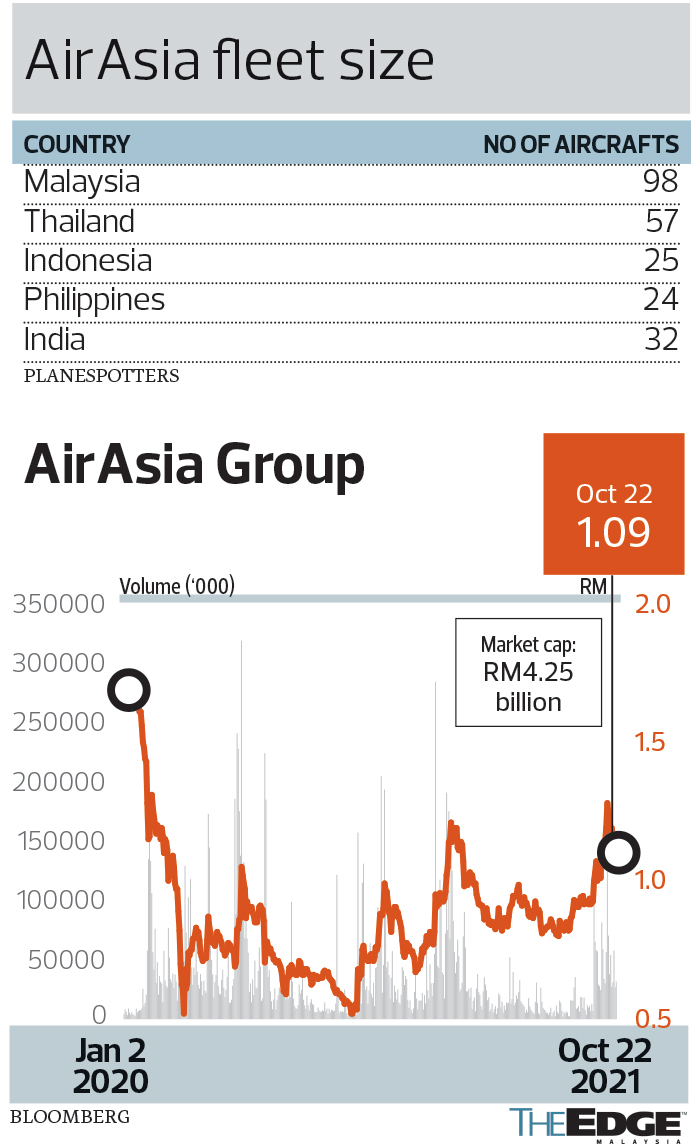
This article first appeared in The Edge Malaysia Weekly on October 25, 2021 - October 31, 2021
AIRASIA Group Bhd has announced a proposed financial restructuring of its Thai operations, which will involve a capital injection and restructuring of the shareholding in its 45%-owned Thai AirAsia Co Ltd (TAA).
The development is not unexpected, as AirAsia had previously laid out its intention for its affiliates to seek financial support from the respective countries that they operate in.
In a nutshell, the Thai restructuring seeks to raise fresh capital of up to THB6.3 billion (RM784.96 million) out of the total THB14 billion announced. AirAsia’s effective shareholding in TAA will be diluted to 40.7%, from 45%.
With some form of restructuring happening in Thailand, Malaysia and India, Indonesia AirAsia and AirAsia Philippines could be next in line.
This also raises the question of how much AirAsia needs in the pocket as each of these associates undertake their own recapitalisation and restructuring exercises.
It is a tougher situation for Indonesia AirAsia and AirAsia Philippines, according to analysts. Thailand is a bigger, more profitable segment, while India had the right backing.
“AirAsia India is supported by [its largest shareholder] Tata Group … but nobody is really supporting Philippines and Indonesia aside from Malaysia (AirAsia Group),” an analyst points out.
Details of Thai AirAsia restructuring
Under the restructuring, Thai-listed Asia Aviation PCL (AAV) is injecting THB3.9 billion into TAA by taking up a bank loan. AAV will be issued new shares for additional capital pumped into the carrier.
With the fresh cash TAA will repay debts of THB3.9 billion to AirAsia, which will dispose of its entire remaining stake in TAA to AAV for THB3.8 billion, making TAA a wholly-owned unit of AAV.
AirAsia will then subscribe to AAV’s proposed private placement and rights issue, of which its portion amounts to THB9.5 billion, making AAV a 40.7%-unit of AirAsia.
PublicInvest Research, in an Oct 22 note, said the restructuring will help raise the necessary funding for TAA’s working capital and for jumpstarting operations “in a market heavily tourism-dependent and gradually reopening to travellers”.
However, it also pointed out that AirAsia’s participation in AAV’s private placement exercise would result in unrecognised losses in TAA — estimated to be RM791 million — immediately crystallising, and “knocking off 20 sen from AirAsia’s net earnings and net asset per share”.
AirAsia’s portion of fresh capital injection into the Thailand business amounts to RM181.06 million, that is, if AirAsia utilises its entire proceeds from TAA for the fundraising.
It has also been reported that Thai AirAsia and Thai AirAsia X were among seven airlines seeking a combined THB5 billion in soft loans from the Thai government.
According to Planespotters data, the Thai operation has 57 aircraft, of which 13 are in service.
In comparison, AirAsia has an effective stake of about 40% in AirAsia Philippines (PAA), which controls a fleet of 24 aircraft, five of which are in service.
AirAsia also controls just over 49% in PT AirAsia Indonesia TBK (AAID), which has 25 aircraft, six of which are in service.
In the past year, AirAsia has talked about raising up to RM2.5 billion from cash calls and debt to survive the pandemic.
An analyst said that this amount will be used mainly to support the Malaysian division, which was operating 98 aircraft at end-June.
“The restart costs are high and fuel costs are also elevated,” the analyst said. “They may need RM2.5 billion to restart, but every other plane added to the working fleet will add a lot more to the costs.”
Another analyst concurred. “The fundraising by AirAsia [so far] is certainly not enough [for the wider group]. AirAsia’s annual aircraft lease liabilities alone is about RM1.8 billion, and the lease restructuring will only be finalised by year end. “
Recall that AirAsia pared its stake in AirAsia India (AAI) to 16.3% in December 2020, having sold 32.67% to Tata Group for US$37.66 million (approximately RM152.58 million at the time). Tata Group, which now owns 83.7% in AAI, also has a call option to buy the remaining 16.3% from AirAsia.
Separately, AirAsia’s Japan operations filed for bankruptcy in November 2020.
Cash calls in the works
Currently, AirAsia is seeking to raise up to RM1.02 billion via a two-for-six rights issue of unsecured Islamic debt securities (RCUIDS) as part of its RM2.5 billion recapitalisation plan.
It is a more dire situation at sister company AirAsia X Bhd (AAX), with a creditors meeting set for Nov 12 to vote on its restructuring plan. This includes a proposed 99.5% haircut as part of a restructuring of RM63.5 billion in debt.
The troubled long-haul carrier is also planning to raise up to RM300 million via a cash call, and up to RM200 million from a placement exercise for new investors.
The two listed companies are controlled by co-founders Tan Sri Tony Fernandes and Datuk Kamarudin Meranun.
AirAsia intends to secure the undertakings from the duo, who control 26.4% of the company and have the right to subscribe to RM257.27 million or 25.1% of the intended RM1.02 billion rights issue.
The duo also have an effective stake of 29.46% in AAX, excluding the 13.76% held by AirAsia. This means that a full subscription of just the RM300 million rights issue alone entails them forking out RM88.38 million, while AirAsia may need to provide RM41.28 million.
Shares of AirAsia settled at RM1.09 on Oct 22, valuing the low-cost carrier at RM4.25 billion. The counter has gained nearly 93% in the past one year. AAX shares settled at nine sen apiece, giving it a market capitalisation of RM354.67 million.
Save by subscribing to us for your print and/or digital copy.
P/S: The Edge is also available on Apple's App Store and Android's Google Play.

